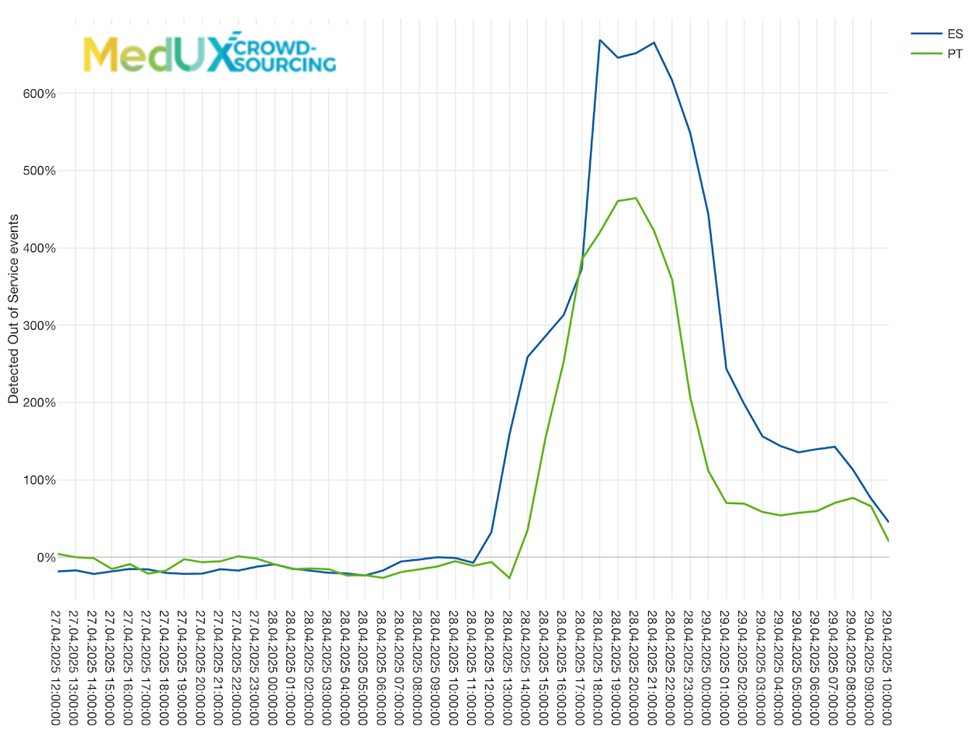Spain and Portugal’s Historic Blackout: How Crowdsourcing Exposed the Impact on Mobile Network QoE

On April 28, 2025, Spain and Portugal faced one of the most disruptive blackouts in their modern history. While the electricity outage made headlines, it was the collapse of mobile connectivity that truly revealed the fragility of digital infrastructure. At MedUX, we monitored the entire incident through our real-time crowdsourcing platform, delivering unique insights into how the blackout affected mobile network Quality of Experience (QoE) for millions of users.
Please, register on our site here for a free copy of our report
When the Lights Go Out, Connectivity Follows
As the blackout spread, hundreds of thousands of users were abruptly disconnected. Beginning in the early afternoon, "Out of Service" events surged dramatically, peaking in the evening hours. In Spain alone, the scale of service loss reached record levels. Portugal experienced a sevenfold increase in network disruptions compared to typical days.
Even after midnight, "No Service" events remained high, showing a slow and uneven recovery.
“The April 28 blackout revealed the essential role of continuous QoE monitoring to ensure resilience and recovery. Networks fell back on legacy 2G/3G systems, and real-time analytics exposed major service availability drops, latency spikes, and user experience disruptions.”
— Jaime González, CMO at MedUX

Please, register on our site here for a free copy of our report
Methodology: Crowdsourcing and Real-Time Insights
MedUX uses a crowdsourcing-based approach that differs from traditional speed testing. By embedding a SDK into third-party apps and dedicated tools, we collect passive and active data directly from users’ devices. This allows us to monitor:
Network speed, latency, and availability in real time; fallback behaviors across technologies (2G to 5G); and actual app performance, including streaming and browsing quality.
This methodology is key in crisis scenarios like the April 28 blackout, enabling us to assess real-world impacts from the user perspective, not just the network layer.
Regional Network Availability: Uneven Impact, Uneven Recovery
Our data revealed strong geographic disparities in how the blackout disrupted connectivity. While the Balearic Islands, Canary Islands, and País Vasco maintained high levels of network availability at the beginning of the blackout, regions like Madrid, Valencia, Murcia and Cataluña experienced sharp drops, with availability falling below 80% at peak outage.
Recovery timelines also varied widely. Some regions began stabilizing before midnight; others didn’t fully recover until well into the next day.
Please, register on our site here for a free copy of our report
Technology Usage Patterns: A Fall Back on Legacy Networks
When modern network layers failed, devices fell back on older technologies. Our data shows a marked increase in the use of 3G and 2G networks during the most critical hours. At peak disruption, nearly one in four users connected via 3G. The return to legacy layers prolonged until the morning of April 29, indicating how long full recovery took.
This behavior highlights the importance of maintaining fallback options and the challenges of transitioning to next-gen networks without redundancy.
Service Quality: What the Users Really Experienced
Connectivity didn’t just drop — the quality of the experience declined significantly. MedUX metrics revealed:
- Download speed dropped by up to 35%, averaging only 8 Mbps.
- Upload speed hit a low of 1.5 Mbps, impacting file sharing and video calls.
- Latency surged over 250%, reaching 73 ms — critical for VoIP, gaming and real-time apps.
- Browsing times spiked — Facebook exceeded 2.8 seconds in page load time.
- Video quality collapsed: Over 40% of YouTube sessions dropped to low/medium resolution.
TikTok, Instagram and other video-centric platforms suffered noticeably — playback delays, buffering, and lower media quality became the norm during peak hours.

Please, register on our site here for a free copy of our report
The Value of Real-Time Crowdsourcing in Crisis Scenarios
This blackout was a powerful reminder of how dependent society has become on uninterrupted digital connectivity. It also demonstrated the unique value of real-time crowdsourced QoE monitoring:
- It captures user-centric massive network, service and quality of experience indicators
- It detects regional and temporal disparities.
- It informs faster, more equitable recovery strategies.
MedUX QoE Crowdsourcing offers a new standard for understanding and improving telecom resilience under pressure. While others analyze speeds, we measure the true user experience.
For detailed insights and comprehensive data from our 5G QoE study, contact us at hello@medux.com.
Don’t forget to follow us on social media and subscribe to our newsletter to receive the latest updates and news.
Follow us on:
About MedUX
MedUX is the leading Quality of Experience (QoE) company, providing comprehensive and innovative solutions for measuring the performance of fixed, mobile, and TV telecommunications networks for telecom operators, governments, and digital enterprises. With a focus on delivering grand scale, end-to-end network, and service visibility, MedUX leverages real-time customer perspective data and advanced analytics to ensure quality and regulatory compliance, while also offering valuable insights for optimizing networks and improving customer experiences. With a presence in over 25 countries across Europe, America, Africa, and the Middle East, and monitoring over 60 operators worldwide, MedUX’s patented technology and expertise make it a trusted partner for improving the digital experiences of customers everywhere.
IMPORTANT NOTICE:
ALL COPYRIGHTS AND TRADEMARKS ARE RESERVED. This article or report has been prepared for the exclusive use and benefit of press media and solely for non-commercial purposes. Press media members are authorized to entirely or partially disseminate, refer, quote, copy, reproduce, distribute, publish, and transfer the report and its findings (including all intellectual property rights, data, content graphs, and analysis) for information purposes with express attribution to MedUX. Use of the report and its findings, entirely or partially, in any form or by any means, by any other third party or for any other purposes (including, commercial or marketing purposes), without the prior written consent of MedUX, is strictly prohibited. Operators can make a request to MedUX for a license to use quality or certification seals, as well as marketing rights to quote the findings. Non-authorized use will be considered a violation of copyright and trademark laws.


